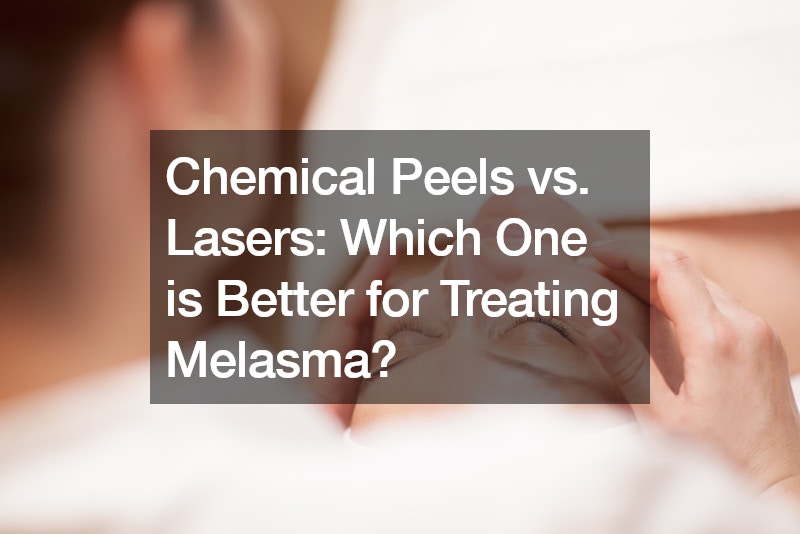
Melasma, a common skin condition characterized by patches of dark discoloration, can be a source of frustration for many individuals. Fortunately, there are treatment options available to help manage and reduce its appearance. Among these options, chemical peels and laser treatments are two popular choices. But which one is better for treating melasma?
Understanding Melasma:
Before delving into the comparison, it’s important to understand melasma itself. Melasma typically affects the face, particularly areas exposed to the sun, such as the forehead, cheeks, upper lip, and sometimes the neck and jawline.
It is more prevalent in women and can be triggered or exacerbated by factors like hormonal changes, sun exposure, and genetics.
Chemical Peels for Melasma:
Chemical peels are a form of exfoliation treatment that involves applying a chemical solution to the skin to remove the outer layer, revealing smoother, more even-toned skin underneath. For melasma treatment, chemical peel treatment can be effective, especially for superficial pigmentation.
One of the advantages of chemical peels is that they can yield noticeable results relatively quickly, often within 7 to 14 days. However, for optimal outcomes, multiple sessions may be required, typically spaced six to eight weeks apart. It’s essential to note that chemical peels primarily target superficial pigmentation, so they may not be as effective for deeper pigmentary issues.
Laser Treatments for Melasma:
Laser treatments utilize concentrated beams of light to target and break down melanin (the pigment responsible for skin color) in the affected areas. Q-switch lasers and Pico lasers are two types commonly used for melasma treatment. These lasers offer deeper penetration and can target both superficial and deeper pigmentation.
While laser treatments may require more sessions compared to chemical peels, they can provide faster results. Pico lasers, in particular, are known for their ability to deliver noticeable improvements in skin tone and texture in a shorter time frame, typically within a few sessions.
Comparing the Two:
When considering chemical peels versus laser treatments for melasma, several factors come into play. Chemical peels offer the advantage of requiring fewer sessions and providing faster results for superficial pigmentation. However, they may not be as effective for deeper pigment issues.
On the other hand, laser treatments, especially Pico lasers, can target both superficial and deeper pigmentation, offering more comprehensive results. While they may require more sessions and come with a higher cost, they can be more effective for stubborn or deep-seated melasma.
Choosing the Right Treatment:
The choice between chemical peels and laser treatments ultimately depends on various factors, including the severity and depth of the melasma, skin type, and individual preferences. Consulting with a dermatologist or skincare professional is crucial to determine the most suitable treatment approach.
In some cases, a combination of treatments, such as a chemical peel followed by laser sessions, may be recommended for optimal results. Additionally, ongoing maintenance with topical treatments and sun protection is essential to prevent melasma from recurring or worsening.
Lifestyle Modifications and Skincare Routines
Melasma treatment isn’t just about clinical procedures; it also involves adopting healthy lifestyle habits and a consistent skincare regimen. Lifestyle modifications can significantly complement medical treatments by promoting overall skin health and preventing further pigmentation. Patients with melasma should prioritize sun protection by wearing broad-spectrum sunscreen with a high SPF daily, avoiding peak sun hours, and wearing protective clothing, hats, and sunglasses when outdoors. Additionally, incorporating gentle skincare products that contain ingredients like vitamin C, niacinamide, and retinoids can help improve skin tone and texture.
Maintaining a balanced diet rich in antioxidants, vitamins, and minerals can also support skin health and reduce inflammation. Drinking plenty of water and avoiding excessive alcohol consumption can contribute to skin hydration and overall well-being. Furthermore, managing stress levels through relaxation techniques such as meditation, yoga, or deep breathing exercises may help minimize hormonal fluctuations and reduce the risk of melasma flare-ups. By incorporating these lifestyle modifications into their daily routine, individuals with melasma can optimize the effectiveness of their treatment and achieve clearer, more radiant skin.
Conclusion:
Both chemical peels and laser treatments offer effective options for managing melasma, each with its own set of benefits and considerations. While chemical peels may be preferred for superficial pigmentation and faster results, laser treatments, particularly Pico lasers, can provide more comprehensive and longer-lasting outcomes for both superficial and deeper pigment issues.
Ultimately, the choice between chemical peels and laser treatments should be based on individual needs and preferences, guided by professional advice. With proper treatment and skincare regimen, individuals can effectively manage melasma and achieve clearer, more even-toned skin.
In summary, whether opting for chemical peels or laser treatments, addressing melasma requires patience, consistency, and professional guidance to achieve the best possible results.
.




